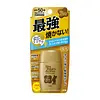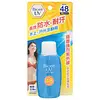What's inside
What's inside
 Key Ingredients
Key Ingredients

 Benefits
Benefits

 Concerns
Concerns

 Ingredients Side-by-side
Ingredients Side-by-side

Cyclopentasiloxane
EmollientWater
Skin ConditioningZinc Oxide
Cosmetic ColorantEthylhexyl Methoxycinnamate
UV AbsorberCetyl Ethylhexanoate
EmollientDipropylene Glycol
HumectantSilica
AbrasiveDimethicone
EmollientTitanium Dioxide
Cosmetic ColorantCetyl PEG/PPG-10/1 Dimethicone
EmulsifyingMagnesium/Aluminum/Zinc/Hydroxide/Carbonate
Polyglyceryl-3 Diisostearate
EmulsifyingDiethylamino Hydroxybenzoyl Hexyl Benzoate
UV FilterHydrogen Dimethicone
Myristic Acid
CleansingAluminum Hydroxide
EmollientTocopheryl Acetate
AntioxidantMethylparaben
PreservativeEthylparaben
PreservativePotassium Alum
AstringentParfum
MaskingButylene Glycol
HumectantDimethicone/Vinyl Dimethicone Crosspolymer
Skin ConditioningBHT
AntioxidantGlycyrrhetinic Acid
Skin ConditioningCamellia Sinensis Leaf Extract
AntimicrobialScutellaria Baicalensis Root Extract
AstringentCyclopentasiloxane, Water, Zinc Oxide, Ethylhexyl Methoxycinnamate, Cetyl Ethylhexanoate, Dipropylene Glycol, Silica, Dimethicone, Titanium Dioxide, Cetyl PEG/PPG-10/1 Dimethicone, Magnesium/Aluminum/Zinc/Hydroxide/Carbonate, Polyglyceryl-3 Diisostearate, Diethylamino Hydroxybenzoyl Hexyl Benzoate, Hydrogen Dimethicone, Myristic Acid, Aluminum Hydroxide, Tocopheryl Acetate, Methylparaben, Ethylparaben, Potassium Alum, Parfum, Butylene Glycol, Dimethicone/Vinyl Dimethicone Crosspolymer, BHT, Glycyrrhetinic Acid, Camellia Sinensis Leaf Extract, Scutellaria Baicalensis Root Extract
Zinc Oxide 10.7%
Cosmetic ColorantEthylhexyl Methoxycinnamate 7%
UV AbsorberWater
Skin ConditioningCyclopentasiloxane
EmollientAlcohol
AntimicrobialLauryl Methacrylate/Sodium Methacrylate Crosspolymer
Dimethicone
EmollientIsopropyl Palmitate
EmollientTalc
AbrasiveGlycerin
HumectantPEG-32
HumectantMethicone
EmollientPEG-12 Dimethicone
Skin ConditioningPolysilicone-9
PEG-3 Dimethicone
Skin ConditioningParfum
MaskingBHT
AntioxidantTocopherol
AntioxidantPhenoxyethanol
PreservativeZinc Oxide 10.7%, Ethylhexyl Methoxycinnamate 7%, Water, Cyclopentasiloxane, Alcohol, Lauryl Methacrylate/Sodium Methacrylate Crosspolymer, Dimethicone, Isopropyl Palmitate, Talc, Glycerin, PEG-32, Methicone, PEG-12 Dimethicone, Polysilicone-9, PEG-3 Dimethicone, Parfum, BHT, Tocopherol, Phenoxyethanol
 Reviews
Reviews

Ingredients Explained
These ingredients are found in both products.
Ingredients higher up in an ingredient list are typically present in a larger amount.
BHT is a synthetic antioxidant and preservative.
As an antioxidant, it helps your body fight off free-radicals. Free-radicals are molecules that may damage your skin cells.
As a preservative, it is used to stabilize products and prevent them from degrading. Specifically, BHT prevents degradation from oxidation.
The concerns related to BHT come from oral studies; this ingredient is currently allowed for use by both the FDA and EU.
However, it was recently restricted for use in the UK as of April 2024.
Learn more about BHTCyclopentasiloxane, or D5, is a silicone used to improve texture of products and trap moisture.
D5 is considered lightweight and volatile. Volatile means it evaporates quickly after application. Once evaporated, D5 leaves a thin barrier that helps keep skin hydrated.
It is also an emollient. Emollients help soften the skin and prevent water loss. Silicones create a silky texture in products. D5 helps other ingredients become more spreadable.
Studies show D5 is safe to use in skincare products. We recommend speaking with a skincare professional if you have concerns.
Learn more about CyclopentasiloxaneDimethicone is a type of synthetic silicone created from natural materials such as quartz.
What it does:
Dimethicone comes in different viscosities:
Depending on the viscosity, dimethicone has different properties.
Ingredients lists don't always show which type is used, so we recommend reaching out to the brand if you have questions about the viscosity.
This ingredient is unlikely to cause irritation because it does not get absorbed into skin. However, people with silicone allergies should be careful about using this ingredient.
Note: Dimethicone may contribute to pilling. This is because it is not oil or water soluble, so pilling may occur when layered with products. When mixed with heavy oils in a formula, the outcome is also quite greasy.
Learn more about DimethiconeEthylhexyl Methoxycinnamate is an organic compound that provides UVB protection. It often goes by the more common name of octinoxate. It is created from methoxycinnamic acid and 2-ethylhexanol.
Ethylhexyl Methoxycinnamate absorbs UVB rays with wavelengths between 280-320 nm. UV absorbers protect your skin by using chemical reactions to convert UV rays into heat and energy.
UVB (290-320 nm) rays emit more energy than UVA rays. They are capable of damaging DNA, causing sunburns and are thought to be linked to skin cancer.
The state of Hawaii has banned sunscreens containing octinoxate due to its potential impact on coral reefs. More research is needed to bridge gaps in this research. The European Union allows higher levels of octinoxate in sunscreens than the US and Australia.
Ethylhexyl Methoxycinnamate is oil soluble. It is not stable and may lose efficacy when exposed to sunlight.
Learn more about Ethylhexyl MethoxycinnamateParfum is a catch-all term for an ingredient or more that is used to give a scent to products.
Also called "fragrance", this ingredient can be a blend of hundreds of chemicals or plant oils. This means every product with "fragrance" or "parfum" in the ingredients list is a different mixture.
For instance, Habanolide is a proprietary trade name for a specific aroma chemical. When used as a fragrance ingredient in cosmetics, most aroma chemicals fall under the broad labeling category of “FRAGRANCE” or “PARFUM” according to EU and US regulations.
The term 'parfum' or 'fragrance' is not regulated in many countries. In many cases, it is up to the brand to define this term.
For instance, many brands choose to label themselves as "fragrance-free" because they are not using synthetic fragrances. However, their products may still contain ingredients such as essential oils that are considered a fragrance by INCI standards.
One example is Calendula flower extract. Calendula is an essential oil that still imparts a scent or 'fragrance'.
Depending on the blend, the ingredients in the mixture can cause allergies and sensitivities on the skin. Some ingredients that are known EU allergens include linalool and citronellol.
Parfum can also be used to mask or cover an unpleasant scent.
The bottom line is: not all fragrances/parfum/ingredients are created equally. If you are worried about fragrances, we recommend taking a closer look at an ingredient. And of course, we always recommend speaking with a professional.
Learn more about ParfumWater. It's the most common cosmetic ingredient of all. You'll usually see it at the top of ingredient lists, meaning that it makes up the largest part of the product.
So why is it so popular? Water most often acts as a solvent - this means that it helps dissolve other ingredients into the formulation.
You'll also recognize water as that liquid we all need to stay alive. If you see this, drink a glass of water. Stay hydrated!
Learn more about WaterZinc Oxide is a mineral broad-spectrum UV filter; it is the broadest UVA and UVB reflector approved by the FDA. It also has skin protectant and skin soothing properties.
Zinc oxide is one of the most effective broad-spectrum UV filters. It protects against UVB, UVAII, and UVAI. In comparison to its counterpart titanium dioxide, zinc oxide provides uniform and extended UVA protection.
Another great benefit? This ingredient is highly photostable so it won't degrade easily under sunlight.
A common myth is that mineral UV filters are widely believed to primarily reflect UV light.
However, modern research shows titanium dioxide absorbs UV radiation like chemical filters (~95% absorption & 5% reflection).
Zinc oxide has great skin soothing properties so you'll likely find this in sunscreens formulated for sensitive skin or babies/children. It is unlikely to cause "eye sting" like other sunscreen ingredients.
Regulatory agencies consider zinc oxide to be non-toxic and safe. It has also been shown to not penetrate the skin.
Unfortunately, this ingredient does leave a visible white cast. This is why mineral sunscreens are often less cosmetically elegant than chemical or hybrid ones.
In cosmetics, zinc oxide can be found in both non-nano and nano-sized forms. The nano version is used to reduce white cast and improve the texture of sunscreen formulas.
There are ongoing concerns surrounding nano-zinc oxide's impact on marine ecosystems and whether it can be absorbed into skin.
Regarding marine ecosystems and coral reefs, there is no conclusive evidence that any form of zinc oxide (or any other sunscreen ingredients) will cause harm. The science is still developing but many consumers are keeping a close eye on this issue.
Please note, many destinations have reef-safety sunscreen rules. For instance, the U.S. Virgin Islands advises all visitors to use non-nano mineral sunscreens.
There has also been some stir about whether micronized or nano zinc oxide has potential photoxicity and absorption through the skin/lungs.
An in-vitro (done in a test tube or petri dish) study demonstrated micronized zinc oxide to have potential phototoxicity. There's no need to fret; the EU Commission's Scientific Committee on Consumer Safety has stated, "The relevance of these findings needs to be clarified by appropriate investigations in vivo." Or in other words, further studies done on living organisms are needed to prove this.
Current research shows zinc oxide nanoparticles do not penetrate intact or sunburned skin. They either remain on the surface or in the outermost layer of dead skin (stratum corneum).
Zinc oxide is one of only two classified mineral UV filters with titanium dioxide being the other one.
Fun fact: Zinc has been used throughout history as an ingredient in paint and medicine. An Indian text from 500BC is believed to list zinc oxide as a salve for open wound. The Ancient Greek physician Dioscorides has also mentioned the use of zinc as an ointment in 1AD.
Learn more about Zinc Oxide